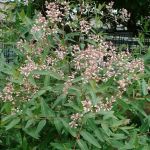| Common Name: |
Dogbane |
| Other Names: |
Bitter Root, Black Indian Hemp, Canadian Hemp, Indian Hemp, Indian Physic, Milkweed, Wallflower |
| Botanical Name: |
Apocynum cannabinum |
| Genus: |
Apocynum |
| Family: |
Apocynaceae |
| Native Location: |
NE USA, Canada |
| Cultivation: |
Well-drained, moist soil in sun or partial shade. May be invasive. |
| Propagation: |
By seed sown in autumn; by division in autumn or spring. Seeds require stratification for successful germination. |
| Harvest: |
Rootstock is lifted in autumn after the plant has seeded, and dried for decoctions, liquid extracts, powders, and tinctures. |
| Height: |
60cm-1.2m (2-4ft) |
| Width: |
60cm-1.2m (2-4ft) |
| Hardiness: |
Z4-8 |
| Parts Used: |
Rhizomes, roots, juice |
| Properties: |
An unpleasantly bitter, stimulant, irritant herb that acts on the heart, respiratory and urinary systems, and the uterus. It has diuretic and expectorant effects, increases perspiration, and causes vomiting. |
| Medicinal Uses: |
Internally for heart failure, intermittent fevers, and tumors. Used by the Cherokee for kidney failure. Externally for venereal warts and baldness. For internal use by qualified practitioners only.
To treat rheumatism, asthma, coughs, syphilis, and heart problems; as a diuretic. |
| Typical Dose: |
A typical dose of Indian hemp may range from 10 to 30 drops of liquid extract, or 0.3 to 0.6 ml of tincture (1:10). |
| Possible Side Effects: |
Indian hemp's side effects include nausea, vomiting, decreased heart rate, and lowered blood pressure. Indian hemp contains cardiac glycosides, which can help control irregular heartbeat, reduce the backup of blood and fluid in the body, and increase blood flow through the kidneys, helping to excrete sodium and relieve swelling in body tissues. However, a buildup of cardiac glycosides can occur, especially when the herb is combined with certain medications or other herbs that contain cardiac glycosides, causing arrhythmias, abnormally slow heartbeat, heart failure, and even death. |
| Drug Interactions: |
| Taking Indian hemp with these drugs may increase the risk of drug toxicity: |
| Acetazolamide, (Apo-Acetazolamide, Diamox Sequels) |
Azosemide, (Diat) |
Bumetanide, (Bumex, Burinex) |
| Chlorothiazide, (Diuril) |
Chlorthalidone, (Apo-Chlorthalidone, Thalitone) |
Ethacrynic Acid, (Edecrin) |
| Etozolin, (Elkapin) |
Furosemide, (Apo-Furosemide, Lasix) |
Hydrochlorothiazide, (Apo-Hydro, Microzide) |
| Hydroflumethiazide, (Diucardin, Saluron) |
Indapamide, (Lozol, Nu-Indapamide) |
Mannitol, (Osmitrol, Resectisol) |
| Mefruside, (Baycaron) |
Methazolamide, (Apo-Methazolamide, Neptazane) |
Methyclothiazide, (Aquatensen, Enduron) |
| Metolazone, (Mykrox, Zaroxolyn) |
Olmesartan and Hydrochlorothiazide, (Benicar HCT) |
Polythiazide, (Renese) |
| Torsemide, (Demadex) |
Trichlormethiazide, (Metatensin, Naqua) |
Urea, (Amino-Cerv, UltraMide) |
| Xipamide, (Diurexan, Lumitens) |
| Taking Indian hemp with this drug may be harmful: |
| Digitalis, (Digitek, Lanoxin)—may increase drug's therapeutic and adverse effects. |
|
| Warning: |
This herb is subject to legal restrictions in some countries. |
| Supplement Interactions: |
Increased risk of cardiac glycoside toxicity when used with other herbs that contain cardiac glycosides, such as Black Hellebore, Calatropis, Motherwort, and others. |
| Bibliography: |
Encyclopedia of Herbs by Deni Brown Copyright © 1995, 2001 Dorling Kindersley Limited. pg 125
The Essential Herb-Drug-Vitamin Interaction Guide by Geo. T. Grossberg,MD and Barry Fox,PhD Copyright©2007 Barry Fox,PhD. Pp.281-282 |

